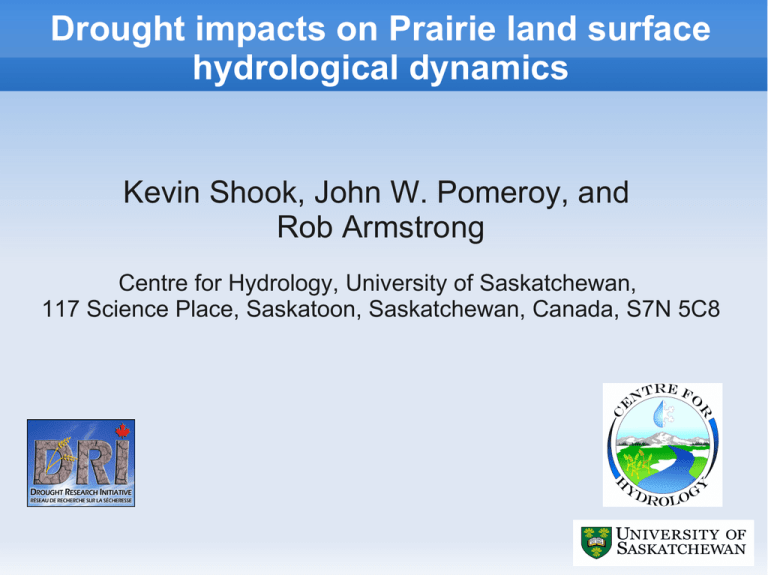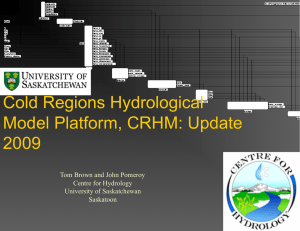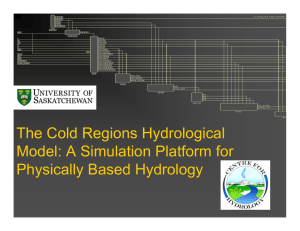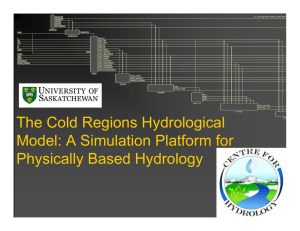Drought impacts on Prairie land surface hydrological dynamics Rob Armstrong
advertisement

Drought impacts on Prairie land surface hydrological dynamics Kevin Shook, John W. Pomeroy, and Rob Armstrong Centre for Hydrology, University of Saskatchewan, 117 Science Place, Saskatoon, Saskatchewan, Canada, S7N 5C8 Prairie hydrology of 1999-2005 drought Hydrology of the Canadian prairies is unique Dominated by small streams and wetlands which are ungauged Evaluation of hydrological effects of 1999-2005 drought will require modelling Ordinary models are useless for prairie conditions Future climate scenarios Hydrological effects of future climate are also unknown in prairies Models developed for this project will also be used to determine effects of future climate changes on prairie hydrology Canadian Prairie Hydrology Wind redistribution of snow to wetlands and stream channels in winter is critical to formation of runoff contributing areas. Frozen soils enhance runoff efficiency during spring snowmelt so that >80% of runoff occurs during snowmelt period. Contributing area small and variable due to post glacial topography, large depressional storage potential and lack of a well developed fluvial drainage network. Baseflow from groundwater often nonexistent due to heavy glacial till substrate. Drainage of small streams and wetlands ceases completely in summer when actual evapotranspiration consumes most available water. Prairie streams are almost completely ungauged and often altered by dams, drainage, water transfers, etc. Prairie Runoff Generation Snow Redistribution to Channels Spring melt and runoff Dry non-contributing areas to runoff Water Storage in Wetlands Modelling Prairie Hydrology Need a physical basis to calculate the effects of changing climate, land use, wetland drainage Need to incorporate key prairie hydrology processes: snow redistribution, frozen soils, spring runoff, wetland fill and spill, noncontributing areas Hydrological models developed elsewhere do not have these features and fail in this environment Streamflow calibration does not provide information on basin non-contributing areas and is not suitable for change analysis Cold Regions Hydrological Model Platform: CRHM Modular – purpose built from C++ modules Modules based upon +45 years of prairie hydrology research at Univ of Saskatchewan No provision for calibration or optimization, parameters set by knowledge Hydrological Response Unit (HRU) basis landscape unit with characteristic hydrological processes single parameter set horizontal interaction along flow cascade matrix Model tracks state variables and flows for HRU HRUs assumed to represent one response type, basis for coupled energy and mass balance HRUs connected aerodynamically for blowing snow and via dynamic drainage networks for streamflow Incorporate wetlands directly using fill and spill algorithm “Virtual” basins The spatial variability of the drought will be simulated using models of two typical prairie basins: 1.a small upland stream, and 2.a small wetland complex The virtual basins will be simulated all over the praries, wherever sets of forcing variables are available Outputs during the drought period will be compared to the climate normal period of 19611990 CRHM model of small prairie stream basin Small stream basin CRHM model HRU1 HRUs 1 and 2 alternate between cropped and fallow HRU3 is grassed HRU2 HRU3 CRHM model of small prairie wetland Small wetland complex CRHM model 3 4 HRU 2 1 2 HRU 1 HRU 3 HRU 1 alternates between cropped and fallow HRUs 2-4 are wetlands HRU 4 CRHM data requirements CRHM requires only a few variables: Daily Hourly Snowfall Rainfall, Air temperature, RH,Windspeed, Solar radiation Solar radiation required for modelling snow melt, evaporation and other processes Currently, measurements are only available at Regina Simulated Data NARR Available as daily or 3-hour values 32 km grid All required variables available, since 1979 Free! but Canadian precipitation data not assimilated by NARR Windspeeds and precipitation are unusable Estimation of Qsi Incoming short-wave radiation (Qs i) can be calculated directly if the atmospheric transmittence is known Many researchers have found simple empirical relationships between daily atmospheric transmittance and the range of daily air temperatures (ΔT) Given the daily estimated Qs i, CRHM can calculate the hourly components of the solar radiation (incoming, outgoing, shortwave and longwave) Annandale Daily Qsi Annandale method yields daily Qsi values about as good as NARR’s Effects of scatter even out over a season Very simple to calculate Now built into CRHM Sites Brandon HRU1 SWE 250 200 SWE (mm) 150 100 50 0 Jan-15 Feb-12 Mar-11 Apr-8 May-6 Jun-3 Jul-1 Jul-29 Aug-26 Sep-23 Oct-21 Nov-18 Dec-16 Jan-1 Jan-29 Feb-26 Mar-25 Apr-22 May-20 Jun-17 Jul-15 Aug-12 Sep-9 Oct-7 Nov-4 Dec-2 Dec-30 1960 1961 1962 1963 1964 1965 1966 1967 1968 1969 1970 1971 1972 1973 1974 1975 1976 1977 1978 1979 1980 1981 1982 1983 1984 1985 1986 1987 1988 1989 1990 1991 1992 1993 1994 1995 1996 1997 1998 1999 2000 2001 2002 2003 2004 2005 Gridded simulation results Drought period values divided by normals for ease of comparison Resulting values gridded (thin-plate spline) to show spatial variability 1999 Annual Discharge/Normal 2000 Annual Discharge/Normal 2001 Annual Discharge/Normal 2002 Annual Discharge/Normal 2003 Annual Discharge/Normal 2004 Annual Discharge/Normal 2005 Annual Discharge/Normal Summary Simulations have been run at all 15 locations using the first CRHM model Simulation results are preliminary The spatial and temporal extents of the hydrological drought can now be visualised Second CRHM model has yet to be used Acknowlegements SGI Canada DRI Data Access Integration ( http://quebec.ccsn.ca/DAI/) for data Apart from CRHM, this research was done entirely with Open Source Software: R - data reduction, statistics Qgis, SAGA - GIS Open Office - presentation








